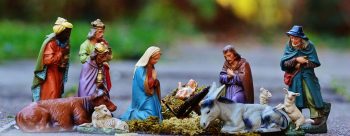Hallacas, gaitas, and baby Jesus: a Venezuelan Christmas Posted by Anais on Dec 24, 2018 in Spanish Culture
Christmas has always been my favorite time of the year. It is the moment to forget about diets and how much you despise your noisy neighbors, and to spend time with your loved ones.
Navidad in Venezuela is by far the most awaited and important time of the year. El espíritu navideño can be felt all the way since mid-November, when shops and bakeries start to decorate and put their arbolitos.
Unlike the United States and other countries, in Venezuela San Nicolás isn’t the generous present giver. Instead, every child excitedly waits for their presents to be brought by el Niño Jesús, who arrives after the kids go to bed on Christmas Eve to bring presents for well-behaved children.
I still remember how exciting it was to wake up and find my presents near the pesebre. Due to the strong Catholic tradition in Venezuela, every home has to have its replica of the manger where Jesus was born.
Santa Claus is also an honored guest in every Venezuelan home, as he is the representation of the Christmas spirit. He is like el Niño Jesús’s sidekick when delivering presents.
My favorite part of Christmas is the food. I wait all year round to eat hallacas, pernil and pan de jamón. That is what our traditional Christmas dish consists of.
La hallaca is a sort of Mexican tamal made out of corn dough and filled with meat, chicken and pork stew and other ingredients including raisins, olives, and capers, which is wrapped in banana leaves, tied with wick and then boiled. El pan de jamón (ham bread) is a brioche bread filled with smoked jam, raisins and green olives. El pernil is pork leg baked and glazed. La ensalada de gallina (chicken salad) is a salad made of potatoes, carrots, peas, chicken, and mayonnaise.
En Nochebuena, after eating our plato navideño, families sit together and open the presents from their amigo secreto (secret friend). Some days or even weeks before Christmas Eve, each family member writes their name on small pieces of paper that are then folded and put on a jar from which everyone take turns to pick one and find out who you will be the secret friend of. On Christmas Eve, you put your present underneath the Christmas tree and wait to find out who is your secret friend.
Venezuelans cheer Christmas time up by the rhythm of gaitas, a musical folk genre which have its roots in the western part of the country, specifically the Zulia state. By means of the distinctive furruco, the beloved cuatro, the charrasca and the tamboras, its lyrics may range from serious social themes to funny, popular jokes.
https://www.youtube.com/watch?v=bVEgSSBLiYE
How do you celebrate Nochebuena in your country? Is there any special tradition you enjoy the most? Tell me in the comments below!
¡Feliz Navidad! 😀
Words to learn:
Amigo secreto: Secret friend.
Arbolito: Christmas tree.
Charrasca: Venezuelan percussion instrument made of a metal cylinder with grating slots in its surface. The sound is produced by rubbing a metal rode against the cylinder.
Cuatro: A variant of the classical guitar with four single strings.
Espíritu navideño: Christmas spirit.
Furruco: A kind of friction drum.
Navidad: Christmas.
Niño Jesús: Baby Jesus.
Nochebuena: Christmas Eve.
Plato navideño: Christmas dish.
Pesebre: Manger.
Tamboras: Percussion instrument similar to the bass drum.
San Nicolás: Santa Claus.

Build vocabulary, practice pronunciation, and more with Transparent Language Online. Available anytime, anywhere, on any device.






Comments:
Julius Nadas:
I’m 73 years old ands have lived in the U.S. most of my life so I am having trouble remembering the details but my recollection of our native Hungarian traditions is that St. Nicholas brought us presents on December 6th and the angels brought the tree and the creche on Christmas Eve which was when we exchanged presents with each other. Thank you for triggering these memories.